 |
| Rockies Snowcover as seen from Space |
 |
| Rockies Snowcover as seen from Space |
|
Wind Graphs from Monday, December 17, 2012
|
|||||
|
Top of the Tram
10,450-ft. at JHMR |
Mt. Coffin
10,850-ft. in the Salt River Range |
||||
|
|
|||||
|
|
||||
Record Wind Gust??
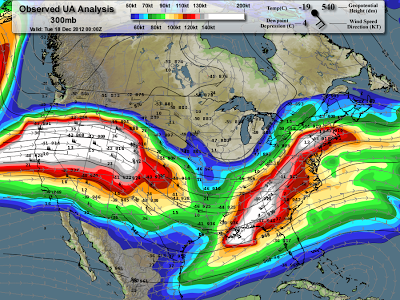 |
| Jet Stream Monday Dec. 17, 2012 |
Update this morning to yesterday’s post: With a foot of new snow at around the 9,500-ft. elevation the last 24 hours, the settled snow depth at the bottom of Rendezvous Bowl at the Jackson Hole Mountain Resort is now deeper than it has been on this date (Dec. 8th) in the last 15 years, with a 61 inch depth reported, that’s a solid 5 feet!
We just surpassed early December 2010 snowdepths (59 inches). You would have to go back as far as Decemeber 1996 to find a deeper snowpack on this date ( 73 inches).
Total snowfall so far this season recorded at the Rendezvous Bowl weather station is 124 inches. Still shy of the total from 2010 on this date (160 inches), but well above the average for this date (104 inches). And far and above last winter’s start with just 87 inches, and only 28 inches of settled snow depth on December 8, 2011.
AND…….the valley got around 3 inches of snow overnight, as well. That should guarantee a White Christmas for Jackson Hole.
Gotta go skiing now……because that foot of snow is all light density stuff!!
Posted by Jim Woodmencey
Posted by meteorologist Jim Woodmencey
It’s Thanksgiving, and technically Winter is still a month away. And the weather pattern that would bring winter on in full is still not quite there yet for the Rockies. Lots of snow the last few days in the Cascades, where cold air and the jet stream have been hanging out. And a little new snow in Jackson Hole this morning from the storm passing through last night. Looks like one more shot of snow this weekend, again starting warmer on Saturday and cooling Sunday into Monday, will also help kick off the ski season.
However, the split jet stream that has been over the Western U.S. needs to go away, and the main Polar Jet stream that carries both Pacific moisture and cold air from the Gulf of Alaska need to dip a little further south. It dipped over us last night, but will stay north of Wyoming Friday & Saturday.
We do see the jet dip south again over the weekend, but then by the middle of next week it looks like it will head back to the north of us. Therefore, we may have to wait a bit longer for that jet to straighten out and get us fully into a winter storm cycle.
(See maps of current jet, forecast jet late Sunday & forecast jet next Thursday).
|
|
|
General Weather Rule of Thumb: When the core of the jet stream is north of us, we get warmer and drier weather. When the jet is right over us, we may get Pacific moisture, but temps may be too warm and we get rain at lower elevations. When the jet is just to the south of us, that is usually when we get our best snowfall.
I’ll keep an eye out for changes and update the long range outlook for you in the next blog post.
Text by meteorologist Jim Woodmencey
Maps from NCAR
A cold low pressure system brought us almost a foot of new snow in the mountains up at around 10,000-ft. in the Tetons over the last 24-hours, and this would certainly qualify as our first good snowfall of the season.
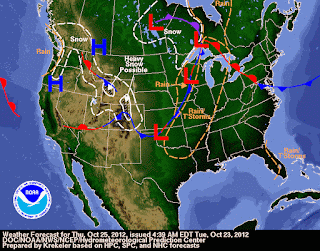 |
| Forecast Weather Map for Thursday Oct. 25 |
|
3-Month Outlook Maps for December- January- February 2012-2013
|
|
|
Temperatures
|
Precipitation
|
Cold Canadian air pushed down through Wyoming on Wednesday, with high temperatures almost 20 degrees cooler in Jackson Hole than they were the day before, on Tuesday. Highs in Jackson Tuesday were in the lower 70’s, on Wednesday we were in the low to mid 50’s.
Low temps this morning (Wed. Oct. 4th) changed even more radically, with overnight temps almost 35 degrees colder than on Tuesday morning…..with lows in the teens most places, whereas the lows on Tuesday morning, before the cold air arrived were in the upper 40’s to near 50.
Coldest temps as of 7:30 a.m. Wednesday morning around the Jackson Hole Region:
Town of Jackson =19
JH Airport = 16
Moose = 14
South Park = 15
Cold air now pushing south into Utah & Colorado. Snowing in North Dakota & northern Minnesota. Snow will be staying well north of the cold front and to the east of the Continental Divide in WY & MT. (See today’s weather map, & forecast map below). See more forecast maps on USA Forecasts Page on mountainweather.com
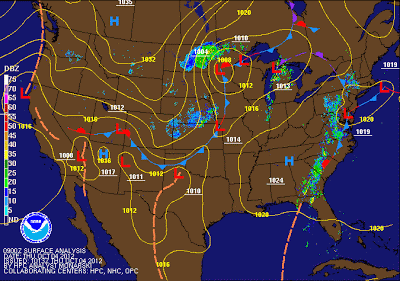 |
| Wednesday Oct. 4, 2012 Surface Analysis |
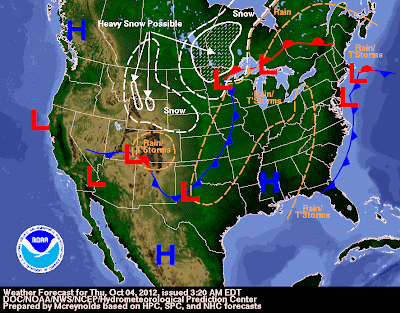 |
| Forecast Map for Oct. 4, 2012 |
Cold air pushing down through Montana this morning, with snow down along the east side of the Continental Divide down to fairly low elevations, like around Pendroy, MT located northwest of Great Falls and just east of the Rockies ( Web cam pic below).
 |
| US Hwy 89 Near Pendroy, MT |
And snowing down into Southwest Montana around Bozeman & Livingston. (See pic from cam on Bozeman Pass). And Beartooth Pass closed this morning, due to winter weather!
Snow showers will push down through parts of Yellowstone Park today, along the Continental Divide.
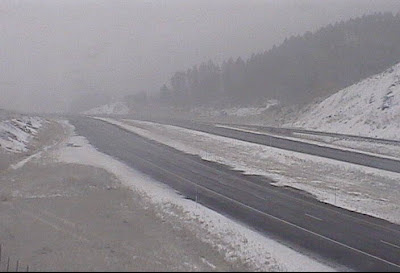 |
| I-90 over Bozeman Pass, MT |
In Jackson Hole, we’ll get the cold air, and the wind out ahead of that push of cold air, but snow will stay east of the Divide. Only a small chance of a few flakes over the west side of the divide in Northwest Wyoming today.
Read more about what is causing the weather this week by reading the “Full Weather Discussion & Outlook” at the bottom of the Jackson Hole Forecast Page.
Post by meteorologist Jim Woodmencey
Wednesday, October 3, 2012